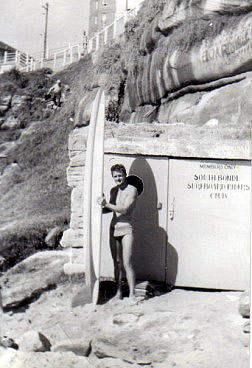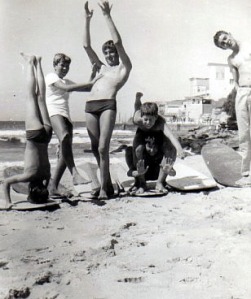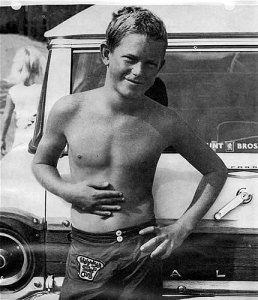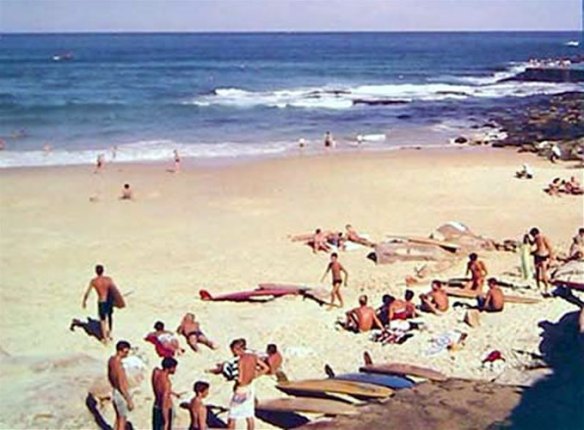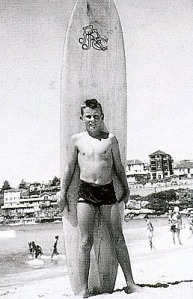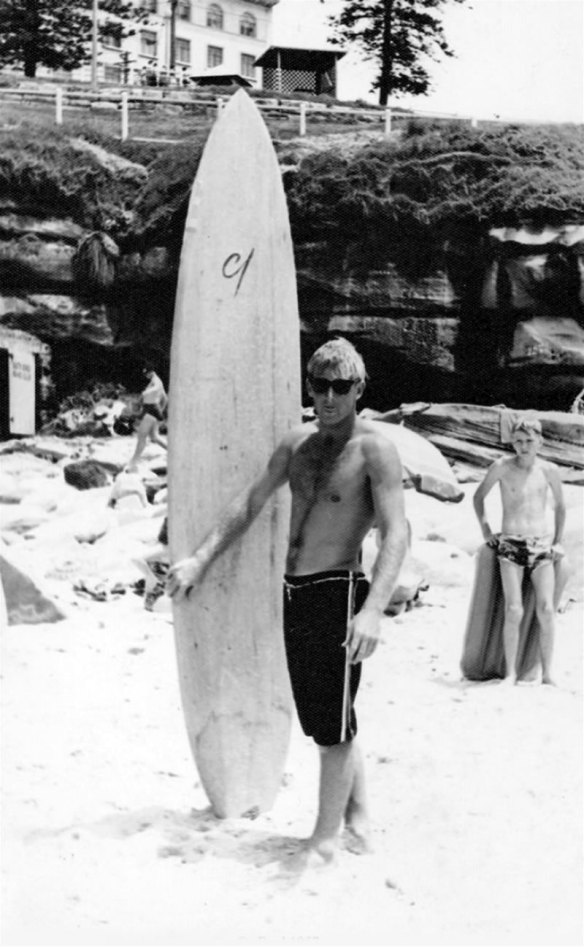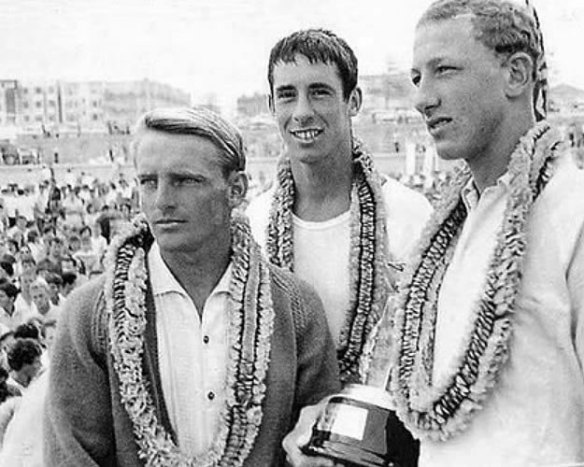An interview with Robert Conneeley
5
BONZA: Looking at the two photos sent to me by Red Ted from Barry McGuigan’s collection. One is a photo of Magoo circa ’59, posing with his board at South Bondi. The photo is taken next to the South Bondi Boardriders shed where the surfers used to keep their surfboards. It was commonly known later as the “Hep Pit” because of the threat of hepatitis from the storm water seepage through the sandstone walls. The other is a shot of the ’61 young crew goofing off on their boards. In the background is the “Icebergs” club and South Bondi reef.
MATT: Why was it actually later named “The Hep Pit”?
BONZA: Well a street drain from Knotts Avenue used to seep through there. On rainy days we would hang inside it unawares of the danger lurking. The actual shed used to butt into the cliff and it picked up a little overhang. Comprised of 1 stonewall and a little bit of a cement roof. The problem was keeping the door on. Not from theft but everyone didn’t have a key so people would bust down the door to get their board out. Boards were so heavy and kids were so young it was a big advantage to have your board down the beach in the corner. A good mate named Frank contracted Hep but no-one really understood. “Where’s Frank today?” “Oh he’s got hep, he’s home sick.” But the boys didn’t even know what it was. Luckily it was isolated.
Looking at Magoo’s surfboard in the photo I think back to the era of boards and when they came through. Everything sparks memories backwards. The first young person I saw with a modern balsa board was Warren Cornish sitting on the beach aged 10. It was a 7’ 6” rounded squaretail. I was the second kid on Bondi to have a modern board. It was the second shipment of Balsa into Australia. It delaminated in the end but it was a great board for a kid. It was 8 foot long 22 wide and I couldn’t fit it under my arm. When I look at the next photo now of the boys we are off the balsa. The guys in this shot were the next squad of young surfers to come down.
MATT: Who was in that squad?
BONZA: Bluey Mayes was ruling the roost, Andy Cochrane and Mick Dooley were the talent and then there were the teenagers meaning 13+. In the photo I can recognize a couple of heads, Kevin Brennan, Warren, Ron Silcock and John Carty. Most guys a little older went to sea or as soon as they turned 18 and could get into a pub you never saw them again. Bobby Fel, Wally the Walker, Jimmy Brown were all moving pretty fast. Pretty much hot shots. And Warren was the kid on the beach. One time he had to put his age up to get a car license. He was pretty mature so he got another birth certificate.

Back:
Robert Coady, Bommy Beacham, Chris Brock, Dennis Lindsay, Paul Witzig,
Mick Delaroo, Gary Keys. Middle: Kevin Brennan, Terry Keys. Front: Steve
Cunningham, Bob Moss, John Coady, Dave Spencer, Robert Conneeley, Frank
Pickford, Ron Silcock.

Jack
'Bluey' Mayes, John 'Wheels' Williams, Scott Dillon, unknown, Darrell
Eastlake, Andy Cochran, unknown, unknown, unknown, unknown, Robert
'Bonza' Conneeley.
MATT: Where was that influence from?
BONZA: California. Hawaii’s influence waned once it went to foam, short-boards and hot-dogging. The Hawaiian influence came back later.
MATT: When talking about B.B. being the pioneer of foam what year was that?
BONZA: Guessing about ’61 or ’62 probably fiddling for years but you can see by the photo the popularity of it. So now you can see there’s half a dozen young kids but there’s only a couple of people missing there. There weren’t too many other young kids surfing.
MATT: Anyone else you want to add?
BONZA: Gary Keys was a part of that clan but lived inland so only came down on weekends. Terry Falson who’s dad was a crown sergeant at the law courts. Probably one of the greatest stylists that North Bondi had in that tubing little right-hander was Brian Morris. Lived up there on Ben Buckler and he was really influential in stylizing Bondi surfing. But we were shamelessly copying John Severson’s Surfer magazine Vol 1. They were the first black and white photos of people throwing out a bit of style and then it was just an outbreak of Mike Doyle hold the nose, one hand up. In the second photo the two guys crouched are good examples. The top guy is doing a Mickey Munoz ‘Quasimodo’. Someone in the photo is also doing the ‘Duke’ ornament which is almost the O’Neill advertisement. And of course ‘Kev the Head’ on his head was the most versatile, athletic, best balanced, could switch foot, ride backwards do virtually anything….. seen him paddle out with a cigarette dry and ride the first wave and flick it when he got to the nose. He was a great talent.
MATT: And what about The Baths?
BONZA: For me my interests in establishments. The Baths and North Bondi Surfclub started with my dad so I had been down on Bondi since I was really, really young. Dad was in the Bondi Icebergs so every Sunday he’d be up drinking jugs of beer and eating prawns after having his Winter swim. Mum and I would be down in the south corner out of the wind with the brolly up and as a baby I would just head straight down to the water.
So by 2½, they could see that I was either gonna drown or they better teach me how to swim. So, over at the baths the swimming coach was Sep Prosser who became an Olympic swimming coach in Copenhagen or somewhere like that. Sep would use a couple of kerosene tins with a belt around them under your arms and then throw you in. The first floaties. Once I was able to get going I ended up being anti-clubby. You had to be 14 to join. By the time I was 11 and the slightly older blokes, brother-in-law exempted, Peter Moscatt, were giving me the shits. They didn’t like young blokes hanging around because they were bullshitting and telling stories and I was just a fly on the wall passing by. So I was really happy to get my board out of there, cause I used to collect it there because dad was a member, and move it down to South Bondi and hang with guys like Magoo, Tony Rule, and observe the late, great Bluey Mayes and learn the social pecking order of how to fit in with hard men. That was a community. It was nurturing. There were bouncers down there after hours, there were boxers, some hard, tough men. They nurtured young blokes. They didn’t teach you any bad habits and if you were respectful you were part of their community so they would look out for you. a) that you didn’t drown and b) that you didn’t get into any trouble because at times there were all sorts of creeps hanging around. There were pedophiles lurking around the toilets so it was good to belong to such a community that cared about you. So, as a young guy you felt part of the tribe.
MATT: When talking about ‘the hep pit’ it’s obvious that was the general meeting place for the whole tribe or was there different parts of the beach which had their respective crews?
BONZA: It was before the splintering. Bondi Surfclub was first in and they were established and good rowers and so on. North Bondi Surfclub probably in second and they were more radical guys. They were more stage wrestlers and boxers.
MATT: Footballers?
BONZA: Footballers didn’t have a lot of clout in the early days. There was no big deal you just played football. I’m talking ‘Hollywood George’, the wrestlers and the nightclub bouncers coming down to stay fit. So, North had all the characters but the renegades that wouldn’t do community service, wouldn’t patrol beaches on a Sunday because they wanted to go surfing were at South Bondi. So, surfclubs were full of clubbies and the few surfers with boards were at the South end. There was only the one social hang for surfers around ‘the Hep pit’ where our boards were locked up. No other gang just that corner. The only other was if people had tied their surfboard to the roof of the car. Now we’re talking big boards, and not a lot of people had cars or racks. Later on there was the ‘1st ramp’ crew and I bump people now in their early 50s who say you wouldn’t remember me I was at the ‘2nd ramp’. (Laughs) It’s funny but when you start out somewhere as just a kid and there’s not a lot of other people around and it just continues to grow, I was a little naïve to the social pecking order because I was in with the crowd but they weren’t so much the in crowd, they were the only crowd and then the rest of the crowds grew. But how it looked when I talked to an eloquent guy like Damian Lovelock, author and lead singer of the Celibate Rifles, he felt like he was looking in and a little bit socially ostracized. I think Di’s younger brother had once told him to hop it because he dropped in on him or something and I think his interest in board riding waned and he became a body surfer. He just didn’t want to take it on, it was a bit all too much.
MATT: At what age did you start riding a board?
BONZA: I’d been running, swimming, body surfing big waves with guys from North up till I was about 10 years old. At 10 and a little bit I was looking at 16 foot hollow boards and the toss up was ‘do you want to go with a board like that or would you prefer a 12 foot plywood yacht, a VJ?’ We lived up on the Dover Height’s hill in Military Road so it was either to the beach with a plywood Malibu, they had just come down to 10’ 6”, or over to Watsons Bay with a 12 foot Vaucluse Junior. We had a canoe kicking around that we used down the south coast where we had a weekender. One of my dad’s good mates who also built a weekender on my dad’s nod was Gordon Woods. So he was in North before he moved to Brookvale, so it was decided this balsa stuff was coming so it was on for young blokes.
MATT: With your dad being part of ‘the Bergs’ and your mum hanging down at south how did you become affiliated with the hep pit’ crew?
BONZA: Simple answer to that is pure enthusiasm and some unbelievable child opportunities. My dad swum everyday so I got a lift every morning before school to go for a surf. My dad was semi retired, an SP bookie, he went down ‘the Bergs’ every afternoon and was happy to wait till school got out. So I’d have ½ km dash home from Vaucluse High then into the car and down the beach. I’d be in my boardshorts and out in the water before the school bus had even made it to Bondi. I was accepted because I was just on the beach morning and night. At one stage I can remember a couple of the older guys naming me “Rob the Rocket” because I couldn’t go left. It’d be “Go Rocket” cause they’d see me on a closing out right and I’d just hurtle. So that bit of good humour, that bit of sportsmanship all helped and basically if ‘Bluey’ didn’t want a wave, Dooley and Cochrane dueling for the next one and then there was a bunch of 16 year old guys and I was at the bottom of the pile. Sure enough a little one would come through, they’d yell “Go Rocket” and that was mine. So I’d always be going right on the shorebreak and when I’d turn back around the hierarchy of the beach would go surfing by.
MATT: Similar to your current everyday grommet?
BONZA: Yes, but no grommet abuse. Guys were pretty cool, to me anyway.
MATT: These days or even when I had my day at Bondi occasionally there were grommets who were really easy to like. They didn’t get in the way and they kinda understood the pecking order, they were humble to a degree and therefore easily accepted within the framework.
BONZA: And you warm to their enthusiasm and just with the opportunity I had, arriving fit, good swimmer, could run, dropped all of that and turned it into surfing. If the board was at North Bondi I’d paddle down. A reflection of my father, his joy of life and living life to the fullest. I owe him a huge vote.
Then when it came to get a little bit trickier when Bondi was closing out, what’s next? Almost a badge of honour…. Mick Dooley invited me over North side. Now he mightn’t even remember it but when you’re a grom you never forget it. Mick was a style master. He was up there with Midget Farrelly. Midget had more winning ways in comps but you couldn’t separate the better surfer. Contests did and Midget was, but they were both perhaps the first ‘nippers’ prior to Nipper Williams because they were little guys. They were nothing short of sensational. Mick was a really cool guy. Had the old Holden station wagon and the gal and asked me if I wanted to go North side. So you go from Bondi beach break to the other side of Long reef out at ‘Fishermans’ and ‘Little Makaha’….. just like overwhelming. Big seas. Reef surfing. You know cast in at the deep end with a hero and you just do it! (Laughs)
You can’t say “I’m not going out!” So, that was my first trip away from Bondi to go surfing.
MATT: How old were you?
BONZA: It was my first board so I was 11 or 12 years old. You know I had my 2 shillings lunch money and you’d throw that in for petrol money and the bridge toll and go hungry for the day. I had fruit and stuff packed, I was a spoilt kid. But the big trip came up, which proved to be culturally significant, though I didn’t know that at the time, when Barry “Magoo” McGuigan who had a 1955 Vee Dub, was a fireman with some time off and a bit in the know, took me up the coast, and the big trip at that stage was out of Sydney and up to Catherine Hill Bay. We’d seen photos in California of shooting the pier at Huntington so it was a real romantic, visual thing, riding a mal in 3 foot waves next to the Catherine Hill Bay pier. At first my dad was concerned about Barry. He thought this guy was a bachelor, a vegan, a yogi, lives with his mum and had to put out the word, “Is he straight?” Word came back, 100% cool guy, surfing enthusiast, diver and pure living man. In Bondi and didn’t drink? That’s why he thought something might have been wrong with him. He turned me onto yoga, mashed banana, wheat germ, how to have food with you when you travel that’s good for going surfing. I owe him such a vote of thanks. I’ve seen him a few times but it’s hard to get that across. Thanks mate.
So that was the background to it and when we get there John Severson, the editor of American Surfer Magazine, was there. The surfer he brought out from the States, Bob Cooper, proved to be one of the most influential in Australian surfing culture. Before he was a hippy, think he had a bit of a beard, and was from Santa Barbara. So, straight away it was look at Cooper’s board, which was a Reynolds Yater… check it out… get all the details…. back to Gordon Woods… next minute I’m riding a board designed from a Reynolds Yater… Rincon mal. There was such a stimuli of being in those peoples company, seeing the stylistic surfing of Cooper and his nose riding… he was early days, Makaha and then dropped out later in Australia and now he’s a religious deacon in his church. Possibly a Mormon. But to get access to that level of board was almost impossible. That was the board I took when I first went to Byron Bay. Pulled up and there were no surfers there. Rode “the pass” on a Reynolds Yater style of board, with beautiful fins and rovings edges. Nose riding but not dorky, nose trimming, speeding through the curl line. Surfing Byron at a time when there were no other surfers around but the guys who come down from the Gold Coast, Paul Witzig in a giant black car, Bob McTavish, Russell Hughes, David Chidgey and no-one else? And it’s Easter! And I’m up there with Gary Keys. It was great to meet those guys and they have become lifelong friends. People might say it was a coincidence bumping people but there was no-one else around. If you saw some surfers back then you thought “Oh Good!” now you see some you think “Oh God!”.
MATT: And what year was that?
BONZA: Third year high school… maybe 14. Caught the train up there… about ’62. Yeah and we had an introduction from my dad’s influence in the surfclub to stay at the Byron Bay surf club.
MATT: Who turned you on to the place?
BONZA: The big tip came from John ‘Wheels‘ Williams, had been a tennis coach in Honolulu, but a great surfer and waterman. Lived in Bondi, was a handsome bloke and style guru… social style of clothing that is (Laughs) Beautiful surfer too. He said, “You kids have to get up to Byron, you’d like it. The waves go sideways all the way to the beach.” I thought, “What does he mean sideways to the beach?” But I mean you get there and go… “Oh my God that’s what he means. 500 metres all the way to the beach.” So by the time you’ve done your whole repertoire of tricks and stuff, by the end of the day you’re just taking your shorts off and putting them on your head. You’d just gone mad riding waves. (Laughs)
MATT: Ok can you talk a bit about your Brylcreem advertisement?
BONZA: That’s a bit hard for a bald headed bloke.
MATT: Ok then let’s start with your win in the ’64 World Junior Title, the preparation and how it actually came in the making?
BONZA: It all started with South Bondi Boardriders around ’60 or ’61. Tony Rule, Barry McGuigan and the rest of the crew hosted the first boardriding contest I had ever seen. Clubbies did stuff. South Bondi did nothing… they just went surfing. So now they’re going to have a little comp. they threw up a cadet division. Myself, Cornish…. I’m trying to think of a few other names who were in it, Murray Evans for sure, and you couldn’t separate any of us but somehow I fluked a win. So I got a little tin cup… you beauty! So that kind of starts a “well are you going to go over North side and have a go at Manly?” Bluey Mayes was saying to me, “Go on you’re as good as those blokes! Get over there and show ‘em!” So there was a bit of a run with comps.
Bob Evans who ran Surfing World, took stills, made movies, saw the future and he started setting up these competitions. I disagreed with his vision and personal philosophy but he was accurate. (Laughs) he thought blokes from South Bondi were a bit loutish and not as well educated as some….. and as far as the future was concerned he was a king maker. So he was setting up comps and doing a few things so by ’63 Ampol came to Bondi and sponsored a major event the Australian Title. May have been comps before but this was a big one. There wasn’t any football in newspapers, back then they would only show you the results. So the newspapers became interested and the Sunday columnists got behind this comp and they started giving half a page to me and half a page to Nat Young. “Rivalry at Bondi to be fought out!” etc. Whoaaaa… Nat Young’s going to be in the seniors? Should I have gone in the seniors? And all this associated press which started to spin me out a little bit. So they run the comp, junior final was postponed, Nat wins the seniors and scores a trip to Makaha and California and off he goes. Junior final on the next week, more press and more pressure and a really good surfer from North Avalon who went on to be the British champion after returning home was Rodney Sumpter… and in shitty waves with a bit of size at South, Rodney beats me fair and square. After it I felt flat and a little disillusioned. Wow ’63 and this is what losing feels like… shucks! (Laughs) So ’64 dawns and with a little more of an appetite I go up to North Avalon and turn the tables on Rodney. After that comp they decided they didn’t want Nat in the seniors anymore because he was too good so they put him back in the juniors and made everyone stay in their age group.
A bit of rivalry then started between me and Nat. He can’t remember the occasion but I have discussed it with him… my recollection of the event, because I was behind him, was that he effectively ‘fouled me’ as Peter Drouyn would say. Big left ran down the beach, he took off in front of me, white water came down, I’m on my heels, and I can’t get around the section to catch him. So it is a foul. He wins the event and I’m fuming. I recall trying to get a little closer to him in the water to have a discussion but of course he’s too good a paddler so he wouldn’t have even known it. He could always out paddle anyone.
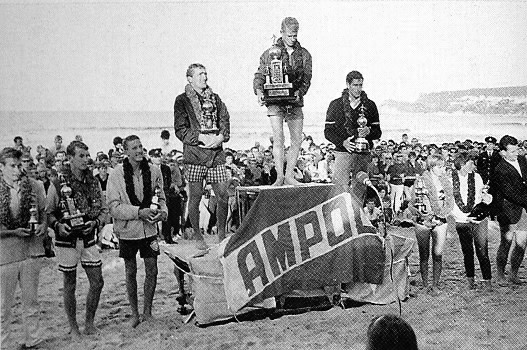
The
1964 World Titles, at Manly Beach. Top: Mike Doyle, Midget Farrelly,
Joey Cabell. Left: Wayne Cowper, Robert Conneeley, Nat Young. Right:
Phyllis O’Donell, Linda Benson. Photograph by Ron Perrott.
MATT: What were the waves like?
BONZA: Pissy little 3 footers but beautiful shape and glassy.
MATT: What about the board you were riding?
BONZA: It was the first board that Glen Ritchie shaped me who went on to make Outer Island Surfboards. It was a 9’ 6” mal and it was a beauty. Glen came from Manly so the board really suited those waves… not that it was made for the event it just happen to be the board I had at the time.
MATT: How was the judging back then?
BONZA: The judging for that event was fine by me. (Laughs) No split decisions… it was a good win. What made it better for me was they brought Phil Edwards out to be a judge who was one of the world’s best at the time. I had this little bit of an underdog thing coming from Bondi that the North side judges, Bob Evans, John Witzig and all were biased. They didn’t like us socially, and possibly for good reason, crashing their party’s and being a bit obnoxious but their bias came out in comps and they were pushing their own agenda. So having an international judge like Phil Edwards really broke through that and the beauty of having a head judge like that who gives you a pat on the back is that he teaches you to drink tequila. So it was the first time we’d had tequila in Australia. Luckily it was after the surf comp. So when I got home to Bondi my mates just propped me up against the door, put the trophy in my arm, knocked and when my parents opened it I just fell in.. (Laughs)
MATT: Being 1964 and way before there was any cash in surfing, how were you earning a crust?
BONZA: In ’64, I got my first job. Professional surfing was years away so I got a job at the Rural Bank of N.S.W. at Double Bay. So I’m 6 months into a job and they were happy with having a sportsman working for them who was kicking a goal. But there was nothing straight business could do with a sportsman So I’m going’ “Gee I’d like to get to Hawaii.” And you would think the purpose of having comps like this would be to pick a team to go… but there wasn’t a lot of dough around and it wasn’t evenly placed. Midget was groomed. Don’t think he went to Peru but he won the seniors at Manly. But as surfers we all just wanted to get to Hawaii and if you went to Peru you passed through Hawaii. We all wanted to compete at Makaha in December ’64. Question was how to get there? I’d had this era of disproportionate media exposure and it was only because there wasn’t a lot going on. It wasn’t as though we were riding great waves and I had plenty of mates who were better surfers but I just happened to win the comp. Sure I was on a roll but you never thought you were better than Kevin Brennan. (Laughing) He’d just go out and trounce you any day of the week he just couldn’t keep it together or show up. He had a disadvantaged life.
So, then this advertising agency gets in touch with me. “Would you like to do a TV commercial for Brylcreem?” I was just starting to listen to the Rolling Stones, wanted to grow my hair out like Brian Jones but couldn’t cause I was working in a bank…. I didn’t listen to much Beach Boys music and here’s Brylcreem trying to put their product into Beach Boys hairstyles that were basically just starting to grow into Rock n’ Roll hairstyles. I thought, “This could be tricky. What sorta dough are we talking here?” And it turned out to be enough to buy an ocean liner ticket to Hawaii return because it was cheaper than an aeroplane. Bob Spence, the president of the Australian Surfriders Association, was going and said to me, “You should get on it. There’s a few blokes from Narrabeen going and we can be a team!” (Laughs) Team? Yeah right I just wanted to get to Hawaii.
So, we filmed a hair commercial at Newport Reef. They had some pretty quaint ideas of what I should be doing. It was closing out on the inside ledge and it’s hard to film surfing and back then for commercial cameramen, not surf photographers, it was really difficult. And they were trying to get some slang in there, a bit of a logo going. So anyway they got this shot of me hitting the inside ledge and the whole wave was about to close out so I launched the board in this flickout. Ah, ok what are they going to call it? “The Whip-Turn Pullout”. And then of course they cut back to this mock set of change rooms and I’m there running a comb through my hair. I reckon it must have been all that vanity that made my hair fall out. (Laughs) But that was the price of a ticket to Hawaii in those days.
MATT: Tell us a bit about the background behind the ocean liner tradition to Hawaii?
BONZA: Well in ’61, Farrelly went over and won and I assume the world knows that. That is a very worthy piece of Australian history and established him as a leader of Australian surfing and a clean living man. Great example and was shaping his own boards. His Makaha series were excellent, beautifully foiled boards. Let’s hope history’s got him in his place but were talking about the Bondi end of it… the mongrel end of it….. and in ’63 there was always a big send off drink at the boat. All your mates would come down and everyone would get pissed, cheap booze on the boat with no duty on it. So, Bob McTavish was down there one time and not drinking too heavy and he figured he’d take a big wave board with him and not just see the boys off but stay on board. Another friend David Chidgey was with him and wasn’t as well organized but thought, ‘That’s a great idea!” So they just jumped in the lifeboat and off they went. They got to Hawaii, landed, got onshore and ended up with jobs on the North Shore painting houses. Such was the power of Sunday newspapers and their surfing columns that a girl from Dover Heights was writing her column and mentioned what a laugh it was that McTavish and Dave had stowed away to Hawaii. The American embassy in Australia read it and they got busted for being illegal immigrants and were brought back in irons.
So, in ’64, when it was time to go, my dear friend Dr Robert Spence, the accident surgeon from Manly hospital, who was just this mad, keen surfer, up early every morning, huge waves, Fairy Bower, Bombora, mate of Scott Dillon’s, 40 years of age and just powered up wanting to do Hawaii… come on the team Rob you’re on with us.
So after the big send off drink… balancing along the railing… gladioli between the teeth… falling and thinking “Is this the end?”… luckily fell inboard…. hit the deck and thought, “Ah that’s good!” If you fell off an ocean liner on the first night to N.Z. they’d never have found you. You can’t put the hand brake on and stop one. So then we started to get into some serious training and there’s a ships pool to take advantage of. I think the ships name was the “Orsova”. We nicknamed it the “Arse Over”. The pool was a fairly decent size and so we started doing laps underwater getting ready for hold downs in Hawaii. I already had a good lung capacity, I had never smoked. Anyway first go underwater was 3 laps. Then we couldn’t break through 7 laps heading for 10. So day after day we’re just doing these laps and then as you cross the equator there’s the ‘King Neptune’ celebrations where they have a big water festival on. Someone gets dunked in the pond, King Neptune comes out with his trident and there are all sorts of games happening. So, one of the games illustrates what we were working at. They got a tray of the ship’s cutlery and dumped it into the pool and then it’s a contest of who can gather the most knives and forks. Im watching people do this and I’m thinking, “Too easy.” (In a mock Scottish accent) So under I go holding my breath, rake it all up into a pile at the foot of the ladder. I then hooked one leg under the rung of the ladder so I’m still hanging on the bottom and picked up every piece…. Filled the cozies, fill the hands… so I’ve picked up the whole tray of cutlery. Whatever the prize was… you know King for 5 minutes….. but besides that no-one could still break the 7 laps underwater. So that night after a little celebratory drink, think we were drinking Bacardi, I thought, “I’ve got to break this pain barrier.” So that night pissed, on my own, just the lights of the pool…. Whoosh, whoosh, up and down… 7 laps and through the barrier. My hearts just throbbing, boom… boom… Next minute I didn’t have arms or legs, all I had was a pulsating pain. 9 laps. (Laughs) 10 laps and suddenly there was no pain and I was in no hurry to come up. Fortunately I lifted my head out of the water because I reckon I was heading for a blackout. Pissed at 11pm and I don’t think anyone would have found me in time.
Finally on the tenth day of the cruise there’s this little blimp on the horizon and you could smell Oahu. The trade winds just blowing it at you. The first thing you noticed as you got close was the Aloha tower. A big wooden structure standing upright in Pearl Harbour… it looked like a mega hand built bungee tower. It was there to welcome all tourists because all tourism from California and elsewhere mainly came by boat. After getting on shore we were met at the Outrigger Canoe Club by John Kelly. He took us around and showed us the place, you know we were the Australian team. (Laughs) There were guys tagging along who could hardly surf. “Yep, yep, we’re all in the Australian team!” (More laughs). So, that was the start of a fantastic cultural experience. That training and pain barrier thing came in handy. I remember straightening out at inside Sunset Beach on a 10 foot gun with the lip clobbering me and I really needed it!
MATT: So where did you stay?
BONZA: Right on the point at Sunset. At some accommodation that was owned by Mrs Zeigler. She had about 6 little cabins in a coconut grove.
MATT: And tell us about the Makaha contest?
BONZA: As a competitive junior at age 17 I was in awe of Makaha. Met Buffalo and the guys and they were just gentleman. Beautiful royalty of surfing and so loved them, got on. Went drinking with Buffalo… age limit was 20… I was already a veteran drinker by 17. So I could hold cheap, lite, Hawaiian piss, no problem, and stay up drinking with them all night.
And then you meet the Californians. Butch van Artsdale, who was Mr Pipeline that year, Mike Hynson, the stylist. They were too cool to compete. Smokin’ hot one’s, and no-one cared about that. They’d seen the movie before so they didn’t have to play. But in the juniors was the hot tip from La Jolla, Billy Hamilton. Laird’s stepfather, and this guy was just red hot. Never saw anyone surf like him. Fine railed board just ripping. Was dong all that Johnny Fain was doing at Malibu, stylistically with perfect poise… just blew my mind! I’d never seen a better surfer. Rodney Sumpter was also in the comp but what they did was eliminate all those guys in the semi so they didn’t clutter up the final with true contenders. So then Fred Hemmings’ young brother was shuffled through and a couple of other Hawaiian kids that they wanted to win. I was put through as a token Australian being the Aussie Junior champ. I was just making up the numbers to make the system look good. There was an article in “New Idea” that my daughter did with a photo of me looking at the place getters trophy. I was seriously contemplating throwing the thing. The better surfers were eliminated on the way through. In that final there’s a kid riding backwards to impress his dad who was sitting on the beach, Hemmings senior who was half blind. And that wins whereas I’d just seen Billy Hamilton do the most cosmic surfing I’d ever seen in my entire life… and it doesn’t even qualify for the final? All said and done the comp wasn’t that important it was just an excuse to get to Hawaii.
My first job at the bank couldn’t sponsor me but they gave me half pay over there in pounds, shillings and pence which worked out to be about $9 a week. We were nearly starving to death to stretch the holiday out for 3 months. I was writing a few things back for the Sydney Telegraph. They were trying to put a package together for me to get down to Peru for the World Championships in Feb 65’. Bob Evans organized a paddle contest on Sydney Harbour sponsored by ‘Milo’ and Nat beat every clubby, every paddler in the whole of Australia easily… and yelled back abuse at them, “C’mon can’t you keep the pace!” Subsequently won a trip to Peru and came second in the World Championships. I never made it to Peru but Nat was quite likely the best surfer there. I didn’t see it but they weren’t going to let him win, he was too brash. The old Hawaiian judges still held the power then. That’s what built up his head of steam to break through in ’66 and win in California with a more modern format. So I was a little disappointed not to go to Peru. If contests had been my aim in life that was my opportunity slipping by. I was on a roll that year and they had given me time off work when normally I had been a 9 to 5 guy. They were giving me work 10 to 3 so I could surf before and after work. I told them I was in training but I was just going surfing. (Laughs) So, it was the beginning of working the system to fit into a surfing lifestyle.
MATT: Getting back to Hawaii you mentioned to me before that you visited Kauai……
BONZA: No that was in ’68/’69. The first year it was all on the point at Sunset… walking distance…. Some huge seas… a little bit of Waimea too!
MATT: Going back in ’68 was there a big change?
BONZA: Late ’68, of course there was a sham amateurism movement before there was a real surfing industry. Oh, I had a surf shop in Bondi to pay my way so I suppose it wasn’t a complete sham, (Laughs)… but as far as people who are sponsored now can get to a comp without putting there entire life savings on the line…. Things hadn’t really changed…. In Puerto Rico in 68’ where Nat was defending champion the big change was that cosmic culture had broken out. So in 68’ it stopped really being a contest and started being a showcase of different nationalities. Mike Hynson again was down there from California, the Hawaiians were on the paddle pop boards that Brewer had built, and David Nuuiwa had a tent and an entourage. He was the Donovan, a Pied Piper of the surfers, and the most gorgeous of surfers. Wayne Lynch was at his prime and just couldn’t cope with the rigmarole. Ted Spencer was just firing. So it was just this giant gathering of the tribe and people realized it was the world tribe. Some Hawaiians were a little bit more beer culture at the time of marijuana and papaya consciousness. People were becoming vegetarians, the competitive urge was dropping off, there was only so far you could go with competition anyway. What would it matter if you hadn’t.
MATT: So people were just embracing the lifestyle?
BONZA: The lifestyle, the cosmic ness of it. Nuuiwa was just an icon in California and was on a payroll just to be himself. To surf beautifully and just be a cosmic character.
MATT: Was there any really defined progress in surfing from ’64 to ’68?
BONZA: The big shift was in the hands of McTavish. George Greenough’s Northern California influence is sometimes overlooked…. Bob McTavish did all the hard yards. Bob shaped the surfboard versions but was inspired by George Greenough’s Rincon, Point Conception, Reynolds Yater view of surf design… George was a waterman, a crayfisherman, powerboat kinda guy. So, from surf comps in ’66 where Nat won on a mal in San Diego that he’d shaped but was Greenough inspired with a beautiful fin that made the board loose and maneuverable… Nuuiwa was just standing on the nose doing the hood ornament… Nat was standing on the back just carving, getting in the tube and a little nose riding. That was the last of those boards… that was the last clash of those dinosaurs. The next two years boards were just coming down. Henson had made progress with rocker. Brewer always knew about rocker but he was working on a more aeroplane dynamic type board. The Aussies with their Greenough influence were working on a more water hydro orientated model, drawing from boats and fish. So, Brewer was a plane, Greenough boards were a fish and seem to flex and move more with the wave. Subtle planning on top of the water and gliding. The Aussie boards were fitting into the wave and there was just this giant cosmic show of that. The Hawaiians, namely Brewer, went cosmic and his riders were Lopez and Reno Abellira. At this stage Lynchie was making his boards, Nat would make a board, Ted Spencer would borrow my board… people were happy to lend their boards, it was before legropes.
At the ’68 World Title comp in Puerto Rico the waves were a bit light. It was like let’s get back to the North Shore and do this jam again. At that comp the Hawaiian old establishment was still a powerful judging block. They had the wealthy Peruvian’s on side. Edwardo Arena was president of World Surfing. The surf comp In Puerto Rico was to promote his real estate development. He’d just bought all the land around where the comp was at. We were just pawns in his real estate promotion and getting no money out of it. We all had to pay our own way. There he was advertising his land to everyone during the contest. The winner they selected that year was Fred Hemmings Jnr who went from there to New York to an advertising agency to get all Edwardo’s stuff in place… then went back to the islands setting his course to go into Hawaiian politics. So in saying that there has been a very powerful conservative block come out of Hawaii and then equally influential, but entirely different, cosmic culture come out of there also. That was the big split. That was the end of sham amateurism and professional surfing was next.
MATT: You could almost relate that to the South Bondi surfers breaking away from the Clubby movement?
BONZA: Yes, more for the purity of surfing.
MATT: Getting back to Greenough… when did he come to Australia?
BONZA: Probably around ’65. He used to hang out with Hayden Kenny. Bob Cooper advised him to come. The ironic thing was that once George and McTavish revolutionized board design we exported it back to the Americans.
MATT: Ok, then when did this shift from ‘Toes on the Nose’ on the world stage occur?
BONZA: Right there and then in Puerto Rico. I met Billy Hamilton again traveling with MacGillivray and Freeman making the movie ‘Free Ride’ and he was also with Mark Marteson… and these were the classic exponents of highly refined malibus. They got to Puerto Rico and saw the modern boards modeled on Greenough and Brewer designs that the Aussies were riding and all the filming they had done traveling around the world became obsolete that very day and they had to start from scratch. That began Billy Hamilton on his course to go back to Pupukea for that hallmark cutback that you saw later. Brewer was doing his boards. He then started shaping his own boards and then moved to Kaui. For me it was back to the North Shore via California and it was starting to get a bit scratchy….. The hippies had moved in…. it was crowded compared to ’64 with no-one around… and the word was get up to Kauai. Joey Cabell was just blowing minds riding Hanalei Bay. At the airport on my way back from Cal I bump Reno who introduces me to Dick Brewer. “Hi Rob, loved ya surfing… how’s your Greenough board? What day you coming to Kauai? I’ll meet ya at the airport.” So when I arrived there he met me in an old pick up truck. Back to his house and I meet his wife Betty. “Rob, you’re welcome. You can see how many hippies we’ve got staying at the house. Lend you a tent, here’s a stretcher, gonna need a raincoat at Hanalei. Put you down there in a nice little grove near the water with a nice view. You’ll want to know fat Paul here… he’s Gerry Lopez’s coach. He’s got the Kombi full of surfboards. What do you want to use?” Well I went from a meat eating, drinking traveling student of the world to next minute the ‘Papaya Consciousnesses’. The same consciousness Cabell and Mike Doyle had been talking to me about. I ran out of money. All I had was air tickets and I didn’t want to go home cause I couldn’t get the money to get away again. So I’m living there on paw paws, bananas and drinking from the fresh stream nearby. Occasionally, I’d walk by a hippy camp and they’d share some brown rice with me. Living on air and ganja. Just surfing 6 to 8 hours a day.
So coming back to Bondi was a little harsh after that. A little bit of a comedown. I looked out to sea and thought, “The whole east coast is in a bay.” (Laughter) I realized the swell had to come around the corner and up the coast. Then I thought, “I wonder what’s happening on the west coast?” And it took a couple of years to get it together but that’s when the plan to move came. Had the surf shop at Bondi, put in a manager, tuned in, turned on and dropped out!
Copyright © 2006 by Matthew Ellks.

